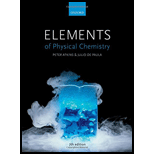
Concept explainers
(a)
Interpretation:
Standard enthalpies of the given reaction whether increases (or) decreases with increasing temperature should be decided.
Concept introduction:
Enthalpy is the amount energy absorbed or released in a process.
The enthalpy change in a system
Where,
Standard free energy change:
Standard free energy change is measured by subtracting the product of temperature and standard entropy change from the standard enthalpy change of a system.
(a)
Explanation of Solution
According to second law of
Where
Given enthalpy reaction is,
Plugging in
Therefore, the
(b)
Interpretation:
Standard enthalpies of the given reaction whether increases (or) decreases with increasing temperature should be decided.
Concept introduction:
Enthalpy is the amount energy absorbed or released in a process.
The enthalpy change in a system
Where,
Standard free energy change:
Standard free energy change is measured by subtracting the product of temperature and standard entropy change from the standard enthalpy change of a system.
(b)
Explanation of Solution
Second law of thermodynamic changes in enthalpy
Where
Given enthalpy reaction is,
Plugging in
Hence, the internal energy
As temperature increase and
(c)
Interpretation:
Standard enthalpies of the given reaction whether increases (or) decreases with increasing temperature should be decided.
Concept introduction:
Enthalpy is the amount energy absorbed or released in a process.
The enthalpy change in a system
Where,
Standard free energy change:
Standard free energy change is measured by subtracting the product of temperature and standard entropy change from the standard enthalpy change of a system.
(c)
Explanation of Solution
Second law of thermodynamic changes in enthalpy
Where
Given enthalpy reaction is,
Put in
Therefore, the
Want to see more full solutions like this?
Chapter 2 Solutions
Elements Of Physical Chemistry
- Can I get helpp drawing my arrowsarrow_forwardWhich of the m/z values corresponds to the base peak in the mass spectrum shown? 100 80 A. 45 B. 44 C. 29 D. 15 Intensity 20 0 10 20 30 40 B- m/z -8 50 E. 30 Which of the m/z values correspond to the molecular ion for the compound shown? A. 18 B. 82 OH C. 100 D. 102 E. 103arrow_forwardCan someone help me with drawing my arrows.arrow_forward
- I'm having trouble with converting lewis diagrams into VSEPR diagrams. I currently have this example of C2BrCl3 which I want to turn into a lewis structure, but I'm not sure what steps I need to do in order to do so. I have the table written down, however, there's two central atoms so what would I do? There seems to be 4 electron domains on the carbon atom and no lone pairs so it would seem like this shape would be tetrahedral. Here's what I have now. Thanks!arrow_forwardWe discussed the solid phase resin using in peptide synthesis. Provide a mechanism, for its formation. DRAW THE MECHANISM.arrow_forwardPlease help. Every time I've asked an expert in the past, it's been wrong :(arrow_forward
 ChemistryChemistryISBN:9781305957404Author:Steven S. Zumdahl, Susan A. Zumdahl, Donald J. DeCostePublisher:Cengage Learning
ChemistryChemistryISBN:9781305957404Author:Steven S. Zumdahl, Susan A. Zumdahl, Donald J. DeCostePublisher:Cengage Learning ChemistryChemistryISBN:9781259911156Author:Raymond Chang Dr., Jason Overby ProfessorPublisher:McGraw-Hill Education
ChemistryChemistryISBN:9781259911156Author:Raymond Chang Dr., Jason Overby ProfessorPublisher:McGraw-Hill Education Principles of Instrumental AnalysisChemistryISBN:9781305577213Author:Douglas A. Skoog, F. James Holler, Stanley R. CrouchPublisher:Cengage Learning
Principles of Instrumental AnalysisChemistryISBN:9781305577213Author:Douglas A. Skoog, F. James Holler, Stanley R. CrouchPublisher:Cengage Learning Organic ChemistryChemistryISBN:9780078021558Author:Janice Gorzynski Smith Dr.Publisher:McGraw-Hill Education
Organic ChemistryChemistryISBN:9780078021558Author:Janice Gorzynski Smith Dr.Publisher:McGraw-Hill Education Chemistry: Principles and ReactionsChemistryISBN:9781305079373Author:William L. Masterton, Cecile N. HurleyPublisher:Cengage Learning
Chemistry: Principles and ReactionsChemistryISBN:9781305079373Author:William L. Masterton, Cecile N. HurleyPublisher:Cengage Learning Elementary Principles of Chemical Processes, Bind...ChemistryISBN:9781118431221Author:Richard M. Felder, Ronald W. Rousseau, Lisa G. BullardPublisher:WILEY
Elementary Principles of Chemical Processes, Bind...ChemistryISBN:9781118431221Author:Richard M. Felder, Ronald W. Rousseau, Lisa G. BullardPublisher:WILEY





